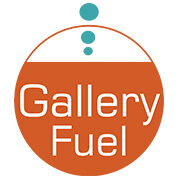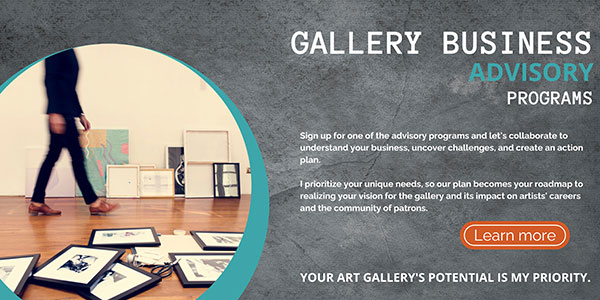In this article, I want to help you realize all the benefits an art gallery client relationship management (CRM) system could provide your business and give you some direction for selecting the perfect tool for your needs.
What if you could simplify and optimize your communications between prospective art buyers and the gallery? How could that impact revenue for your gallery business and your artists?
The art world is not exactly known for being on the cutting edge of technology adoption. However, I’m still pretty shocked when I speak with a client who does not have an actual contact and inventory management database in place. Or they pay big bucks for an art gallery CRM and only use it for a fraction of its capability and ignore all the rest of the powerful features it can do. Tragic.
Now that galleries are finally starting to return to some level of normalcy, some of the new digital sales and marketing tactics you put into play during the COVID-19 shutdown still need to be maintained.
As you try to plan in-person events and still create compelling online experiences, this probably means running the gallery takes more time and effort. But, hopefully, sales leads are coming in from lots of online channels as well as from face-to-face meetings to show you the extra work is paying off.
 How an art gallery CRM will provide operational efficiency and help you sell more art
How an art gallery CRM will provide operational efficiency and help you sell more art
If you are losing track of leads or find you’re dropping the ball on follow-ups, you should seriously consider your client relationship management system. There are so many fantastic software options designed specifically for art galleries and maximizing art sales opportunities.
I understand many small galleries put off investing in this kind of software due to budget concerns or fear of a new tech to learn. I think that is a mistake. It is one of the best investments you can make to drive sales. CRM software is also crucial to any business development strategy you aspire to put in place.
If you’re using spreadsheets or email to keep track of inquiries, you could be limiting your opportunities. These tools are inefficient for keeping track of sales, nurturing client relationships, and expanding your collector base. You have to work twice as hard, and it’s not sustainable. You know the expression – Work Smarter, Not Harder – right???
I’m sure at least half of your time (probably more) is spent creating exhibitions and working with your artists. So it would help if you had the client management aspect of running the art gallery be as powerful and as easy as possible. It’s impossible to maintain all those relationships and to keep track of the details. You need to remember which client bought what and who was interested in a particular artist.
Without a central location to house this essential information, you’re bound to let lucrative opportunities fall through the cracks.
When you think about selling a work of art, you should be focusing on who on your contact list could be buying it. They are the ones who keep your artists creating and the gallery lights shining, not the artwork itself.
If you have a large pool of potential buyers on your list, you can’t keep track of everyone on a personal level. You can’t keep all that information about their tastes, needs, timing, budget, and how you know them in your head. Well, maybe if you have a photographic memory. Do you have a photographic memory? No? Get a good database to help you then.
What to look for in an art gallery CRM system
Today there are several excellent options for art galleries. Of course, they all have pros and cons, but I’m sure there is one out there that will make your gallery hum with efficiency, drive more sales and fit your budget.
Below are some features that you might look for based on your needs. This list is by no means all-inclusive of the features offered by gallery CRMs. You are also not likely to find one that will do it all, but I hope this list will give a starting place for identifying what you need.
- Tagging, sorting, and filtering contacts needs to be straightforward for you to implement. This is one of the most powerful features, so you don’t have to keep all that information in your head or email folders.
- Connecting inventory and sales invoices to contacts.
- Easily add conversation notes
- Set follow-up reminders and track a prospect through a sales cycle
- Send offers and personalized emails. Even better is having the ability to integrate with your email marketing provider.
- Integration with other online art sales platforms to automate maintaining inventory and information
- Sales reporting and forecasting capability
- Analytics and the ability to customize reports
- Contact form integration to help build your mailing list and tag what source a lead comes from.
- Mobile access to the system and inventory
- Robust data security and regular updates
- Calendar sync capabilities
- Project management or exhibition planning features
- Website integration
- Ecommerce capabilities
- Ability to be customizable for your individual needs
- Exceptional training and support. You need the ability to pick up the phone and ask questions anytime and train new staff when required.
Depending on the features you ultimately go with, you could eliminate other tools that you’re currently paying for. That would help a lot to ease the expenditure of a CRM.
How to choose the best CRM database for your gallery
First, seriously evaluate your needs. You should understand the problems you want your CRM to solve and feel confident the solutions align with your gallery’s business, sales, and marketing goals. Ask yourself these questions.
- What frustrates you about your existing sales and marketing workflows?
- What administrative tasks do staff spend too much time on that would be better spent elsewhere?
- What current systems do you love and don’t want to change/replace?
Make a list of these things. It will help you identify what features are a priority in a gallery CRM system for your needs.
Get recommendations. Ask your gallerist peers what systems they use and why. Then narrow your choices and set up some demos with a sales agent. I also strongly suggest you trial the software before committing. Really getting in and using it will help you think of questions or concerns.
To the point
The impact on revenue earnings for your gallery business and your artists is what it’s all about. Don’t leave money on the table because your focus was pulled in a different direction, and you failed to follow up promptly with a sales lead. A CRM system is designed to help you do that and work more efficiently.
You wake up in the mornings and feel as overwhelmed either. How nice will that be? The critical success factor is finding the right system for your needs and being ready to change how you currently operate. If you and your whole gallery staff are not committed to using a CRM daily and all its features, you could be wasting a lot of money. If you do commit, you could change your business for the better and improve your support for your artists’ careers.
You may also find these articles helpful.
Productivity Strategies for Running Your Art Gallery Business
My Favorite Goal Tracking Tool
Three Technologies that make running your art gallery easier



Leave a Reply